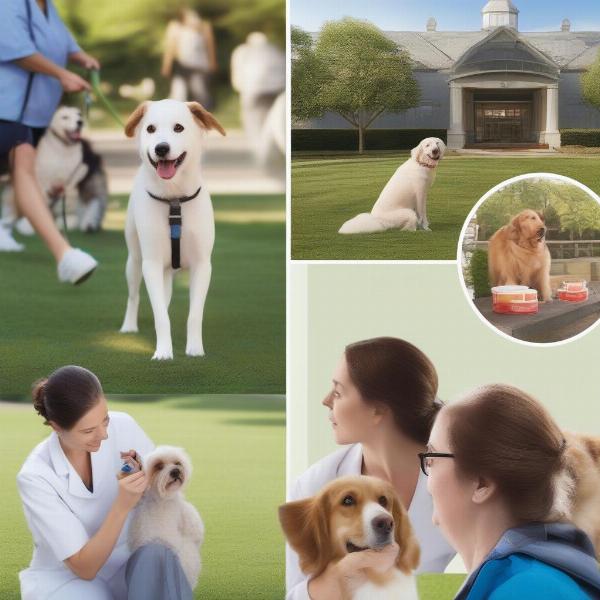Big teddy dogs are more than just pets; they’re fluffy, lovable members of the family. These gentle giants capture hearts with their sweet dispositions and impressive size, offering endless cuddles and unwavering loyalty. Whether you’re already a proud owner or considering adding one of these charming companions to your life, this guide will provide valuable insights into choosing the right breed, understanding their unique needs, and ensuring a happy, healthy life for your big teddy bear dog.
Choosing the Right Big Teddy Dog Breed
Selecting the perfect big teddy dog breed depends on your lifestyle, living situation, and experience with dogs. Some popular choices include the Bernese Mountain Dog, Newfoundland, Great Pyrenees, and Leonberger. Each breed has its unique characteristics, so research is key. For example, the Bernese Mountain Dog is known for its striking tri-color coat and gentle nature, while the Newfoundland is famous for its water rescue abilities and calm demeanor. Consider your living space – a smaller apartment might not be suitable for a giant breed.
Are you prepared for the grooming commitment? These fluffy companions require regular brushing to prevent matting and keep their coats healthy. Newfoundlands, for instance, have a thick double coat that needs considerable attention. Thinking about exercise needs? While generally laid-back, big teddy dogs still need regular exercise to maintain a healthy weight and prevent boredom.
Health and Care for Your Big Teddy Dog
Big teddy dogs, like all breeds, are prone to certain health conditions. Hip and elbow dysplasia, bloat, and certain heart conditions are common concerns. Regular veterinary checkups, a balanced diet, and appropriate exercise are crucial for maintaining their well-being.
 Caring for Your Big Teddy Dog's Health
Caring for Your Big Teddy Dog's Health
What are the common health issues in big teddy dog breeds? Many large breeds are susceptible to joint problems like hip and elbow dysplasia. Bloat, a life-threatening condition, is also a concern. Regular vet visits are essential. Dr. Emily Carter, DVM, advises, “Early detection is key in managing many health issues. Regular vet checkups and a proactive approach to your dog’s health can significantly improve their quality of life.”
Training and Socialization: Raising a Well-Adjusted Gentle Giant
Early socialization is crucial for big teddy dogs. Exposing them to various sights, sounds, and experiences from a young age helps them develop into well-adjusted adults. Positive reinforcement training methods work best with these gentle giants. Focus on rewarding good behavior rather than punishing unwanted actions.
How do I socialize my big teddy dog puppy? Expose your puppy to a variety of environments, people, and other dogs in a controlled and positive manner. Puppy classes are a great way to start. Certified dog trainer, Mark Johnson, recommends, “Positive reinforcement training builds a strong bond between you and your dog while teaching essential obedience skills.”
Conclusion: Welcoming a Big Teddy Dog into Your Life
Bringing a big teddy dog into your home is a rewarding experience. These gentle giants offer unconditional love, companionship, and endless cuddles. By understanding their unique needs and providing proper care, you can ensure a long, happy, and healthy life for your furry friend. Remember to research different breeds, prioritize socialization and training, and schedule regular veterinary checkups. With the right preparation and a lot of love, your big teddy dog will become a cherished member of your family.
FAQ:
- Do big teddy dogs shed a lot? Yes, most big teddy dog breeds shed moderately to heavily, especially during shedding season.
- Are big teddy dogs good with children? Many big teddy dog breeds are known for their gentle nature and are generally good with children, but proper supervision is always necessary.
- How much exercise does a big teddy dog need? While they aren’t high-energy dogs, they still need regular exercise, such as daily walks and playtime.
- What is the lifespan of a big teddy dog? The lifespan varies depending on the breed, but it typically ranges from 7 to 10 years.
- Are big teddy dogs easy to train? Generally, yes. They are intelligent and eager to please, making them responsive to positive reinforcement training.
- What are the grooming requirements for a big teddy dog? Regular brushing is essential to prevent matting and keep their coats healthy. Some breeds may require professional grooming.
- Where can I find a reputable breeder of big teddy dogs? Research breed-specific rescue organizations and reputable breeders who prioritize the health and well-being of their dogs.
ILM Dog is your trusted resource for all things canine. We offer expert advice on dog breeds, health, training, nutrition, grooming, and much more. From puppyhood to senior care, we’re here to help you navigate every stage of your dog’s life. Contact us for personalized guidance: Email: [email protected], Phone: +44 20-3965-8624. Visit ILM Dog for more information and connect with our community of passionate dog lovers.